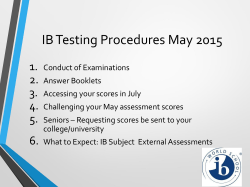
Monthly Multidisciplinary Research Journal
Vol 4 Issue 7 April 2015 ISSN No : 2249-894X ORIGINAL ARTICLE Monthly Multidisciplinary Research Journal Review Of Research Journal Chief Editors Ashok Yakkaldevi A R Burla College, India Ecaterina Patrascu Spiru Haret University, Bucharest Flávio de São Pedro Filho Federal University of Rondonia, Brazil Kamani Perera Regional Centre For Strategic Studies, Sri Lanka Welcome to Review Of Research RNI MAHMUL/2011/38595 ISSN No.2249-894X Review Of Research Journal is a multidisciplinary research journal, published monthly in English, Hindi & Marathi Language. All research papers submitted to the journal will be double - blind peer reviewed referred by members of the editorial Board readers will include investigator in universities, research institutes government and industry with research interest in the general subjects. Advisory Board Flávio de São Pedro Filho Federal University of Rondonia, Brazil Delia Serbescu Spiru Haret University, Bucharest, Romania Kamani Perera Xiaohua Yang Regional Centre For Strategic Studies, Sri University of San Francisco, San Francisco Lanka Karina Xavier Ecaterina Patrascu Massachusetts Institute of Technology (MIT), Spiru Haret University, Bucharest USA Mabel Miao Center for China and Globalization, China Ruth Wolf University Walla, Israel Jie Hao University of Sydney, Australia Pei-Shan Kao Andrea University of Essex, United Kingdom Fabricio Moraes de AlmeidaFederal University of Rondonia, Brazil May Hongmei Gao Kennesaw State University, USA Anna Maria Constantinovici AL. I. Cuza University, Romania Marc Fetscherin Rollins College, USA Romona Mihaila Spiru Haret University, Romania Liu Chen Beijing Foreign Studies University, China Mahdi Moharrampour Islamic Azad University buinzahra Branch, Qazvin, Iran Govind P. Shinde Nimita Khanna Director, Isara Institute of Management, New Bharati Vidyapeeth School of Distance Education Center, Navi Mumbai Delhi Titus Pop PhD, Partium Christian University, Oradea, Romania Salve R. N. Sonal Singh Department of Sociology, Shivaji University, Vikram University, Ujjain Kolhapur Jayashree Patil-Dake P. Malyadri MBA Department of Badruka College Government Degree College, Tandur, A.P. Commerce and Arts Post Graduate Centre (BCCAPGC),Kachiguda, Hyderabad S. D. Sindkhedkar PSGVP Mandal's Arts, Science and Maj. Dr. S. Bakhtiar Choudhary Commerce College, Shahada [ M.S. ] Director,Hyderabad AP India. J. K. VIJAYAKUMAR King Abdullah University of Science & Technology,Saudi Arabia. George - Calin SERITAN Postdoctoral Researcher Faculty of Philosophy and Socio-Political Anurag Misra DBS College, Kanpur Sciences Al. I. Cuza University, Iasi C. D. Balaji Panimalar Engineering College, Chennai REZA KAFIPOUR Shiraz University of Medical Sciences Bhavana vivek patole Shiraz, Iran PhD, Elphinstone college mumbai-32 Rajendra Shendge Director, B.C.U.D. Solapur University, Awadhesh Kumar Shirotriya Secretary, Play India Play (Trust),Meerut Solapur (U.P.) Address:-Ashok Yakkaldevi 258/34, Raviwar Peth, Solapur - 413 005 Maharashtra, India Cell : 9595 359 435, Ph No: 02172372010 Email: ayisrj@yahoo.in Website: www.ror.isrj.org Loredana Bosca Spiru Haret University, Romania Ilie Pintea Spiru Haret University, Romania AR. SARAVANAKUMARALAGAPPA UNIVERSITY, KARAIKUDI,TN V.MAHALAKSHMI Dean, Panimalar Engineering College S.KANNAN Ph.D , Annamalai University Kanwar Dinesh Singh Dept.English, Government Postgraduate College , solan More......... Review Of Research ISSN : 2249-894X Impact Factor : 3.1402(UIF) Volume-4 | Issue-7 | April-2015 Available online at www.ror.isrj.org “A COMPARATIVE STUDY OF THE ENVIRONMENT AWARENESS AMONG PRIMARY SCHOOL TEACHERS IN RELATION TO THEIR SCHOOL TYPE IN NAINITAL DISTRICT” Ranjana Tiwari M.Ed student, Department of Education, SRM University, NCR Campus, Modinagar. Co-Author Details : Neeta Sharma Assistant Professor, Department of Education, SRM University, NCR Campus, Modinagar. ABSTRACT: This research paper explores the level of environmental awareness among primary school teachers. The teacher is the bone of society and he plays a very important role in the d e v e l o p m e n t o f s t u d e n t ’s personality. So if a teacher will awa re a b o u t e nv i ro n m e nta l problems, he can play an important role in developing environmental awa re n e s s a m o n g st u d e nt s . Awareness to environment is horizon sweeping ward and presents the totally of social, biological and psychochemical factors individually or collectively that comprise the natural and manmade surroundings. The term”environment” therefore can cover the whole spectrum of science and humanities. Therefore environmental awareness is inter relations and interactions between the living system and life. The environment and the experiences of the children outside the school, vary from place consequently the activities provided then in the school by teachers would also vary so that knowledge, attitudes, skills an d commitment can be build on the solid foundation of experiences the child draws from the environment. KEYWORDS Environmental Awareness, Primary School Teachers, School type. 1 “A COMPARATIVE STUDY OF THE ENVIRONMENT AWARENESS AMONG PRIMARY SCHOOL TEACHERS IN RELATION TO .... INTRODUCTION:The environmental education is the lifetime process for the benefit of mankind and the development of the public. It develops the awareness, skills and solves the problem to improve the quality of environment. The area of teacher Education is different from social science because they are restricted to awareness only. Teachers can keep students in hands-on, active learning that increase their knowledge and awareness about the environment. They will understand the need of a strong environment for themselves and for others. They will be awake of the activates by which they could protect their natural resources and will keep clean air, water and places .Because environmental education encourages query and investigation, teachers can develop among the students serious thinking, problem solving, and effective decision-making skills. Environmentally aware students become citizens who are able to consider various sides of an environmental issue and make responsible decisions as individuals and as members of their community. This environmental education enables children to discover and protect the environment naturally reaching understanding in their own approach. The most important purpose of environmental education in schools is to explain and sensitize the young minds to the environmental problems and concerns. Teachers are to pound in students healthy personal and social attitude and behavior towards environment. Thus, teachers must have awareness about environment and the problems connected with it so that they can play their function very effectively. Hence, it is necessary to know how far the primary school teachers are aware about environment and environmental problems. Environment is a global concept today. Environmental education is an approach to learning and not a subject of study. It endeavors to create a way of thinking requiring people to overcome prejudices. Environment education helps in programming learning experiences ranging from the simple to the complex. The principle of environmental education is that it makes the child's education problem-based for understanding the environment and the hazards of pollution. The environmental education curriculum is socially relevant as it how unchecked and unplanned development pollutes air, water, and soil, thereby threatening our subsistence and existence. OPERATIONAL DEFINITIONS OF KEY TERMS: Environment Awareness Environment Awareness may be defined as to help the social group and individual to gain a variety of experiences in and acquire a basic understanding of environment and its associated problems. Primary school teachers Primary school teachers also known as national school teachers are involved in the social, intellectual physical and moral development of pupils in their class. A teacher works with one single class for an entire academic year and is responsible for teaching a wide range of subjects on the National Curriculum. Depending on school size, teachers may have responsibility for more than one curriculum class group and as such will have to divide their time, presenting different material different subjects to students at different levels within a single classroom. 2 “A COMPARATIVE STUDY OF THE ENVIRONMENT AWARENESS AMONG PRIMARY SCHOOL TEACHERS IN RELATION TO .... OBJECTIVE OF THE STUDY:•To find out and compare between the environment awareness in Government and Private Primary school teachers. HYPOTHESES OF STUDY:1-There is no significant difference in mean scores of environment awareness between government and private primary school teachers. 2-There is no significant difference in mean scores of forest including trees awareness between government and private primary school teachers. 3-There is no significant difference in mean scores of pollution awareness between government and private primary school teachers. 4-There is no significant difference in mean scores of energy conservation between government and private primary school teachers. 5-There is no significant difference in mean scores of wildlife and animals awareness between government and private primary school teachers. 6-There is no significant difference in mean scores of environment and related problems of environment awareness between government and private primary school teachers. 7-There is no significant difference in mean scores of population awareness between government and private primary school teachers. 8-There is no significant difference in mean scores of teaching skills of EE between government and private primary school teachers. METHODOLOGY:Keeping in view the research evidence, objects and hypothesis, the research scholar found it suitable to go through descriptive survey method. Population:The scope of the study will be Primary school Teachers only. Sample :The research scholar will be collect to 120 samples for the study and during the collect data. Tools:ENVIRONMENTAL AWARENESS TEST OF TEACHERS (EATT) Environmental Awareness Test of Teachers developed by Dr. SEEMA DHAWAN will be used to collect information about Primary school teachers. 3 “A COMPARATIVE STUDY OF THE ENVIRONMENT AWARENESS AMONG PRIMARY SCHOOL TEACHERS IN RELATION TO .... Statistical Technique:The research scholar will used mean, median, standard deviation, t-test for analysis the data of the study. ANALYSIS AND INTERPRETATION:Ho1:- There is no significant difference in mean scores of environment awareness between government and private primary school teachers. Table .1 Variable Gender N Mean Environment Government 60 Awareness Private 60 S.D. 57.06 5.52 56 6.97 Df 118 't' Level of value significant 0.92 Not significant It is evident from Table.1 that the mean score for environmental awareness of government primary school teachers (M= 57.06) is higher than private primary school teachers (M=56). The computed 't' value is 0.92 which is not significant at acceptable level of environment awareness hence, our hypothesis that "There is no significant difference in mean scores of environment awareness between government and private primary school teachers." is accepted. Ho.2:- There is no significant difference in mean scores of forest including trees awareness between government and private primary school teachers. Table .2 Gender N Mean S.D. Df Variable Level of value significant Environment Government 60 Awareness 't' Private 60 7.62 7.36 3.72 1.35 118 0.50 Not significant It is clear from Table.2 that the mean score for environmental awareness of government primary school teachers (M= 7.62) is higher than private primary school teachers (M=7.36). The computed 't' value 0.50 which is not significant at acceptable level of confidence hence, our hypothesis that " There is no significant difference in mean scores of forest including trees awareness between government and private primary school teachers” is accepted. Ho.3:- There is no significant difference in mean scores of forest pollution awareness between government and private primary school teachers. 4 “A COMPARATIVE STUDY OF THE ENVIRONMENT AWARENESS AMONG PRIMARY SCHOOL TEACHERS IN RELATION TO .... Table .3 Gender N Mean S.D. Df Variable Level of value Significant Environment Government 60 Awareness 't' Private 60 18.02 17.93 2.76 2.64 118 0.19 Not Significant It is evident from Table.3 that the mean score for environmental awareness of government primary school teachers (M= 18.02) is higher than private teachers (M=17.93). The computed 't' value is 0.19 which is not significant at accepted level of environment awareness hence, our hypothesis that "There is no significant difference in mean scores of pollution awareness between government and private primary school teachers." is accepted. Ho.4 : There is no significant difference in mean scores of energy conservation between government and private primary school teachers. Table.4 Gender N Mean S.D. Df Variable Level of value Significant Environment Government 60 Awareness 't' Private 60 4.75 4.46 1.27 1.29 118 1.45 Not Significant It is evident from Table 4 that the mean score for environmental awareness of government primary school teachers (M= 4.75) is less than private teachers (M=4.46). The computed 't' value is 1.45 which is not significant at accepted level of environment awareness hence, our hypothesis that "There is no significant difference in mean scores of energy conservation between government and private primary school teachers." is accepted. Ho 5: There is no significant difference in mean scores of wildlife and animals awareness between government and private primary school teachers. Table.5 Gender N Mean S.D. Df Variable Level of value Significant Environment Government 60 Awareness 't' Private 60 4.5 1.12 3.86 1.02 118 21.3 Significant It is evident from Table.5 that the mean score for environmental awareness of government 5 “A COMPARATIVE STUDY OF THE ENVIRONMENT AWARENESS AMONG PRIMARY SCHOOL TEACHERS IN RELATION TO .... primary school teachers (M= 4.5) is higher than private teachers (M=3.86). The computed 't' value is 21.3 which is significant at rejected level of environment awareness hence, our hypothesis that "There is no significant difference in mean scores of wildlife and animals awareness between government and private primary school teachers." is rejected. Ho 6: There is no significant difference in mean scores of environment and related problems of environment awareness between government and private primary school teachers. Table.6 Gender N Mean S.D. Df Variable Level of value Significant Environment Government 60 Awareness 't' Private 60 17.12 16.66 4.45 3.12 118 0.65 Not Significant It is evident from Table 6 that the mean score for environmental awareness of government primary school teachers (M= 17.12) is lower than private teachers (M=17.66). The computed 't' value is 0.65 which is not significant at accepted level of environment awareness hence, our hypothesis that "There is no significant difference in mean scores of environment and related problems of environment awareness between government and private primary school teachers." is accepted. Ho 7: There is no significant difference in mean scores of population awareness between government and private primary school teachers. Table.7 Gender N Mean S.D. Df Variable Level of value Significant Environment Government 60 Awareness 't' Private 60 5.02 5.15 1.08 1.04 118 0.92 Not Significant It is evident from Table.7 that the mean score for environmental awareness of government primary school teachers (M= 5.02) is lower than private teachers (M=5.15). The computed 't' value is 0.92 which is not significant at accepted level of environment awareness hence, our hypothesis that "There is no significant difference in mean scores of population awareness between government and private primary school teachers." is accepted. Ho.8 There is no significant difference in mean scores of teaching skills of EE between government and private primary school teachers. 6 “A COMPARATIVE STUDY OF THE ENVIRONMENT AWARENESS AMONG PRIMARY SCHOOL TEACHERS IN RELATION TO .... Table.8 Gender N Mean S.D. Df Variable Level of value Significant Environment Government 60 Awareness 't' Private 60 0.66 0.27 0.6 0.36 118 1.2 Significant It is evident from Table 8 that the mean score for environmental awareness of government primary school teachers (M= 0.66) is higher than private teachers (M=0.6). The computed 't' value is 1.2 which is not significant at accepted level of environment awareness hence, our hypothesis that "There is no significant difference in mean scores of teaching skills of EE between government and private primary school teachers." is accepted. FINDINGS On the basis of analysis of data the following may be drawn. 1-There is no significant difference in mean scores of environment awareness between government and private primary school teachers. 2-There is no significant difference in mean scores of forest including trees awareness between government and private primary school teachers. 3-There is no significant difference in mean scores of pollution awareness between government and private primary school teachers. 4-There is no significant difference in mean scores of energy conservation between government and private primary school teachers. 5- There is significant difference in mean scores of wildlife and animals awareness between government and private primary school teachers. 6-There is no significant difference in mean scores of environment and related problems of environment awareness between government and private primary school teachers. 7-There is no significant difference in mean scores of population awareness between government and private primary school teachers. 8- There is no significant difference in mean scores of teaching skills of EE between government and private primary school teachers. CONCLUSION On the basis of the analysis and interpretation of data it may be concluded that environmental awareness scores of government and private male and female teachers of primary schools are more or less same and the difference among their environmental awareness is by chance. REFERENCES 1.Best,johan W.,Khan James V.(2006):Research in Education, New Delhi: Prentice Hall of India 2.Burton.& Bartlett’s.(2005):Practitioner research for Teachers, Paul Chapman Publishing. California:thousand Oaks. 7 “A COMPARATIVE STUDY OF THE ENVIRONMENT AWARENESS AMONG PRIMARY SCHOOL TEACHERS IN RELATION TO .... 3.Dhawan,S.(2008):Environmental Awareness of Pupil Teachers, Indian Journal of Teacher Education,Anweshika,Vol.5,(2).New Delhi:NCTE. 4.http://en.wikipedia.org 5.MHRD,(1986):National Policy on Education-1986:Govt.of india 6.Pradhan (2000) A study of environmental awareness among secondary school teachers. 8 Publish Research Article International Level Multidisciplinary Research Journal For All Subjects Dear Sir/Mam, We invite unpublished Research Paper,Summary of Research Project,Theses,Books and Books Review for publication,you will be pleased to know that our journals are Associated and Indexed,India ¬ Directory Of Research Journal Indexing ¬ International Scientific Journal Consortium Scientific ¬ OPEN J-GATE Associated and Indexed,USA DOAJ ? EBSCO ? ? Crossref DOI ? Index Copernicus ? Publication Index ? Academic Journal Database ? Contemporary Research Index ? Academic Paper Databse ? Digital Journals Database ? Current Index to Scholarly Journals ? Elite Scientific Journal Archive ? Directory Of Academic Resources ? Scholar Journal Index ? Recent Science Index ? Scientific Resources Database Review Of Research Journal 258/34 Raviwar Peth Solapur-413005,Maharashtra Contact-9595359435 E-Mail-ayisrj@yahoo.in/ayisrj2011@gmail.com Website : www.ror.isrj.org
© Copyright 2025









